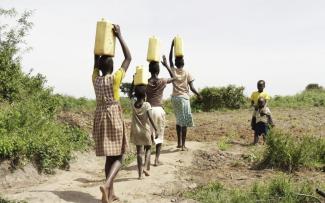Water as a Human Right: A “Last Mile” Problem? Or a “First Mile” Problem?

The United Nations Development Program estimates that as of 2017, 2.1 billion people on the planet lack secure access to safe drinking water, and 4.4 billion people lack access to basic sanitation. This stark reality led to the United Nation’s Sustainable Development Goal Number 6: “Safe and affordable drinking water for all”. Since the adoption of the SDG’s at the turn of the millennium, progress had been made, the proportion of the global population with access to safe water increased from 61% to 71% from 2000 to 2015, and access to sanitation improved from 28% to 45%. This progress has been accompanied by rapid urbanization in developing countries in Latin America, Sub-Saharan and East Africa, and East and Southeast Asia. This leaves hundreds of millions of peri-urban and rural people worldwide without access – these are often members of marginalized groups with limited political or economic power.
The 2019 Stockholm International Water Institute conference theme of ”Water for Society, Including All”, drew attention to these systemic inequities. The concept of the “last mile” problem is popular in the language of both international development and techno-utopianism: the idea that the challenge to overcoming these issues (whether for basic sanitation, electric service, or drone deliveries of Amazon packages) is how to overcome the logistical challenges of reaching the most far flung “customers”, where economies of scale fall apart. However, this technocratic “hub-and spoke” thinking fails to put the need, and the people, at the center of the solution. For the young girl forced to skip school to walk to a clean water source, this is first-mile problem. The answer may ultimately lie not in tweaks to the current centralized systems but in a more ground-up, people-centered approach.
This issue is not limited to rural areas or the developing world. Safe water access is increasingly a challenge in the United States – in aging cities, dying small towns, and rural agricultural settlements alike. These are also areas which have “first mile” problems associated with access to healthy food, healthcare, and public transit. Again, many of these areas are home to minorities and other historically marginalized populations. Perhaps the situation in the U.S. may not be as dire as some developing countries, but there are clear echoes of the systemic inequities which inform public investment decisions on both sides of the global divide.
This is not a technological problem- yes technical improvements can make safe water more affordable, particularly in small, distributed treatment systems. But the technology does exist today to solve this problem. Nor is it fundamentally a lack of financial capability- it is remarkable how water conferences are packed with representatives of private capital looking to find ways to fund infrastructure (for a return). This is ultimately a question of political will – how do we connect the first mile in the field to the last mile up the capitol steps?

